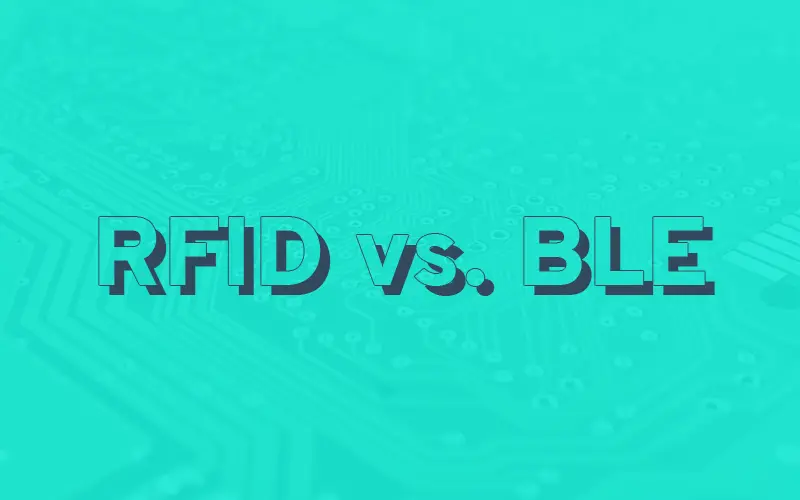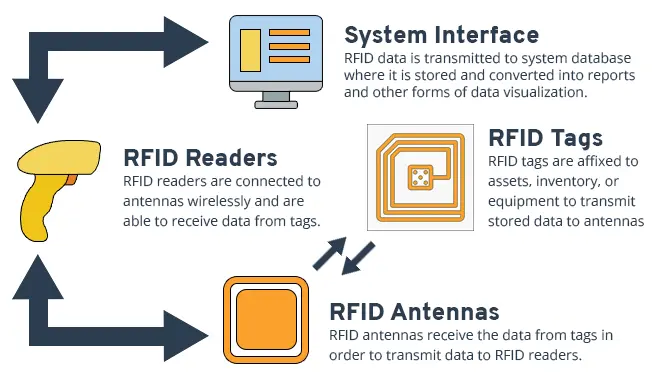
In the era of digital transformation, innovative technologies have become pivotal in driving efficiency, automation, and seamless connectivity across industries. RFID (Radio-Frequency Identification) and BLE (Bluetooth Low Energy) are two such cutting-edge technologies that have garnered significant attention. Both RFID and BLE offer unique features and capabilities that make them well-suited for various applications. In this article, we will explore the differences between RFID and BLE, their respective advantages, and how they are reshaping industries, from supply chain and logistics to retail and asset tracking.
RFID
Harnessing radio waves for identification is what RFID is all about. RFID technology is an established form of wireless communication used for identification and tracking purposes. RFID systems consist of three main components: RFID tags, RFID readers, and a backend database or software for data management.
RFID tags are small, passive devices that can be attached to objects, products, or assets. These tags contain a microchip and an antenna, and they do not require a power source of their own. Instead, they draw power from the radio waves emitted by RFID readers when they come into the read range. When a reader emits radio frequency signals, the RFID tag responds by transmitting its unique identification data, allowing the reader to identify and track the tagged item.
RFID technology is highly effective in scenarios where a large number of items need to be identified rapidly. In industries like logistics and supply chain management, RFID enables real-time tracking of goods, optimizing inventory management, and reducing errors. It is also widely used in access control, asset tracking, and in retail for inventory monitoring and loss prevention.
RFID Use Cases
- Supply Chain and Inventory Management: RFID is extensively used in supply chain and logistics operations to track and manage inventory throughout the entire distribution process. RFID tags attached to products or packages allow for real-time monitoring, reducing errors, improving visibility, and optimizing inventory levels.
- Retail and Point-of-Sale (POS): In the retail sector, RFID tags on products streamline inventory management and enhance the shopping experience. Retailers can use RFID to perform accurate and rapid stock counts, reducing out-of-stock situations and improving shelf replenishment.
- Asset Tracking: RFID is deployed for asset tracking in various industries, such as manufacturing, healthcare, and construction. Companies can efficiently manage and locate valuable assets, equipment, and tools using RFID tags attached to these items.
- Access Control and Security: RFID-based access control systems provide secure and convenient entry management for buildings, offices, and restricted areas. Employees and authorized personnel can use RFID cards or badges to gain access to specific locations.
BLE (Bluetooth Low Energy)
The Power of Proximity and Interactivity BLE, or Bluetooth Low Energy, is a wireless communication technology that operates on the same principle as traditional Bluetooth but with lower energy consumption. BLE is designed for applications where data transfer is required over short distances with minimal power usage.
BLE-enabled devices, like smartphones or beacons, can communicate with one another in close proximity using Bluetooth signals. BLE beacons are small, battery-operated devices that continuously broadcast signals containing unique identification data. When a compatible device, such as a smartphone or a specialized BLE reader, comes into range, it can detect these signals and receive the data transmitted by the beacon.
BLE technology excels in applications that require proximity-based interactions and location-based services. In retail, BLE beacons enable retailers to offer personalized promotions, notifications, and product information to customers’ smartphones based on their proximity to specific store sections or products. BLE is also used in asset tracking and indoor navigation, where it provides precise location data within buildings or facilities.
BLE Use Cases
- Internet of Things (IoT) Devices: BLE is a fundamental technology in the IoT ecosystem. It enables seamless communication between IoT devices and smartphones or gateways, allowing for the exchange of data and commands. BLE is utilized in smart home devices, wearable technology, smart health monitoring devices, and other connected IoT solutions.
- Proximity Marketing and Beacons: BLE beacons are small devices that broadcast signals containing unique identification data to nearby smartphones or devices. This enables proximity-based marketing, providing users with location-based content, offers, and information when they are in close proximity to the beacon. Proximity marketing is widely used in retail stores, museums, airports, and other public spaces.
- Asset Tracking: BLE is employed in asset tracking solutions to monitor the location and movement of objects within a defined area. BLE tags or beacons can be attached to assets such as equipment, inventory, or valuable items. Businesses use BLE-based asset tracking systems to improve logistics, reduce theft, and enhance inventory management.
- Indoor Navigation and Wayfinding: BLE is utilized for indoor positioning systems that enable accurate navigation within large indoor spaces like shopping malls, airports, or exhibition centers. BLE beacons placed strategically throughout the venue interact with users’ smartphones, providing real-time directions and wayfinding assistance.
RFID vs. BLE: A Comparative Analysis
While both RFID and BLE offer wireless communication for identification and tracking, they have distinct features that cater to different use cases. One key difference is the operating range: RFID typically has a longer read range, up to several meters, while BLE operates over a shorter distance, usually up to 30 meters. As a result, RFID is better suited for tracking items across larger areas, while BLE excels in proximity-based applications.
Another difference lies in the power requirements. RFID tags are passive and do not require batteries, which makes them cost-effective and suitable for long-term tracking without the need for regular maintenance. On the other hand, BLE beacons require batteries for operation, which means they need periodic battery replacement.
Additionally, RFID technology allows for simultaneous identification of multiple items within its read range, making it ideal for inventory management in busy warehouses or retail environments. BLE, on the other hand, offers interactive capabilities, enabling personalized interactions with customers through their smartphones, which is advantageous for marketing and customer engagement.
Conclusion
RFID and BLE are powerful wireless technologies that have revolutionized various industries by enabling efficient identification, tracking, and communication. While RFID excels in long-range, high-volume item tracking scenarios, BLE is designed for proximity-based applications and interactive customer experiences. Understanding the unique advantages and use cases of both technologies allows businesses to harness their potential to optimize processes, enhance customer engagement, and drive innovation across diverse industries in the age of smart connectivity.
Interested in RFID?
An RFID tracking system can help organizations of all sizes improve their supply chain efficiency. Contact the CYBRA team schedule a demo today.















 RFID Cage
RFID Cage
